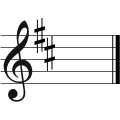D major
D major is a key of the major family of notes, based on the root d. The key of D major is written in musical notation with two crosses (F sharp, C sharp). The corresponding scale and the fundamental chord of this key (the tonic d-fis-a), are also designated with the term D major.

![]()
![]()
![]()
![]()
![]()
![]()
![]()
![]()
![]()
![]()
![]()
![]()
![]()
![]()
![]()
D major is considered the most festive of the keys. This has to do with the fact that in the days of baroque music the baroque trumpets that were sounded on festive occasions were usually tuned in D. Johann Mattheson, a contemporary of Bach, describes D major in his music-theoretical work "Das neu-eröffnete Orchestre" as "most comfortable for noisy, funny, warlike, and upbeat things."
Furthermore, D major is the most common key in Irish folklore, as Irish traditional wind instruments are often tuned in D (e.g. the uilleann pipes). This key is also quite easy to play on the violin.
Key classification
| Keys and their accidentals | |||||||||||||||
| Portent: | 7 ♭ | 6 ♭ | 5 ♭ | 4 ♭ | 3 ♭ | 2 ♭ | 1 ♭ | 0 ♭/♯ | 1 ♯ | 2 ♯ | 3 ♯ | 4 ♯ | 5 ♯ | 6 ♯ | 7 ♯ |
| Major keys: | Ces | Ges | Des | As | It | B | F | C | G | D | A | E | H | F# | C sharp |
| Minor keys: | as | it | b | f | c | g | d | a | e | h | F# | cis | gis | dis | ais |
Questions and Answers
Q: What is D major?
A: D major is a major scale based on the note D. It has two sharps in its key signature.
Q: What is the relative minor of D major?
A: The relative minor of D major is B minor.
Q: Why is it good for violin music?
A: It is good for violin music because of the structure of the instrument, which has four strings tuned to G D A E. The open strings resonate with the D string, producing a special rich sound.
Q: What are some examples of classical composers who wrote violin concertos in D Major?
A: Examples include Mozart's (No. 2, 1775, No. 4, 1775); Ludwig van Beethoven's (1806); Paganini's (No. 1, 1817); Brahms's (1878); Tchaikovsky's (1878); Prokofiev's (No. 1, 1917); Stravinsky's (1931); and Korngold's (1945).
Q: Is it suitable for guitar music?
A: Yes, it can be used for guitar music with drop tuning for the lowest string making two Ds as open strings.
Q: Is it suitable for wind instruments?
A: For some beginning wind instrument students, however, D major may not be a very good key because it transposes to E major which has four sharps and can be harder to play at first; however clarinets in B-flat are often used for music in this key since it probably has the most sharps that can be played well on this instrument.
Q: How was it seen during the Baroque period?
A: During the Baroque period, D Major was seen as "the key of glory"; so many trumpet pieces were written in this key including concertos by Fasch, Gross, Molter (No2), Leopold Mozart Telemann(No2) and Giuseppe Torelli; sonatas by Corelli Franceschini Purcell and Torelli; and "The Trumpet Shall Sound" and "Hallelujah" chorus from Handel’s Messiah
Search within the encyclopedia














